On View
‘We Had the Guts to Say Yes to This’: Artists Explain Why They Ignored Widespread Censure to Participate in Desert X’s Saudi Edition
Artists participating in the controversial show are striving for a message of unity.
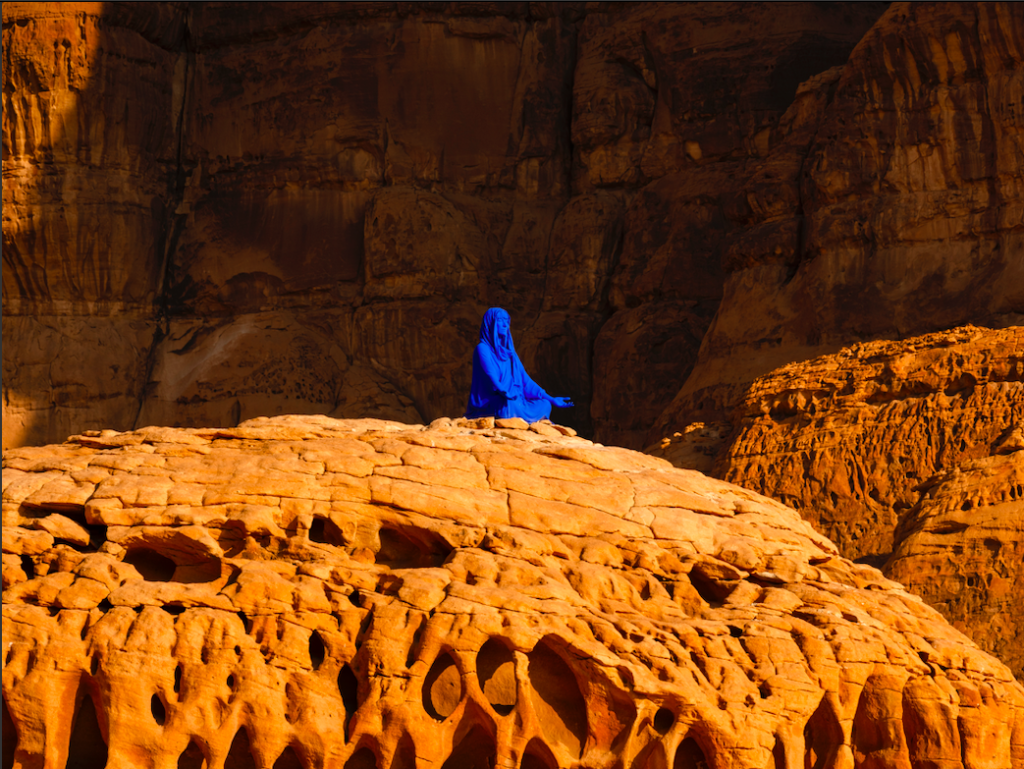
Artists participating in the controversial show are striving for a message of unity.

Rebecca Anne Proctor

Seated atop a big anamorphous rock in AlUla, an ancient oasis in the Medina region of Saudi Arabia, is an electric blue sculpture of a woman seated in the meditative yogic position called “lotus.” Her legs are crossed while her hands extend out with her palms open on either knee. Her eyes are closed as she connects with the silence and nature that surrounds her.
The work, NAJMA (She Placed One Thousand Suns Over the Transparent Overlays of Space) by Santa Monica-based artist Lita Albuquerque, could be the first time in over 1,000 years that a figurative female sculpture has been displayed in Saudi Arabia, where Islamic art forbids figurative representation, especially of women.
Staged as part of the inaugural Desert X AlUla, Albuquerque tells how her fictional female astronaut arrived on earth to spread knowledge and understanding throughout the planet.
“This is a historic moment,” says the artist, who also previously participated in Desert X in Coachella, where the biennial originated. “The doors have finally opened to something collaborative like this bringing international, Middle Eastern and Saudi artists together.” It is historic, she says, not only that the figure is being shown, but that “it is accepted.”
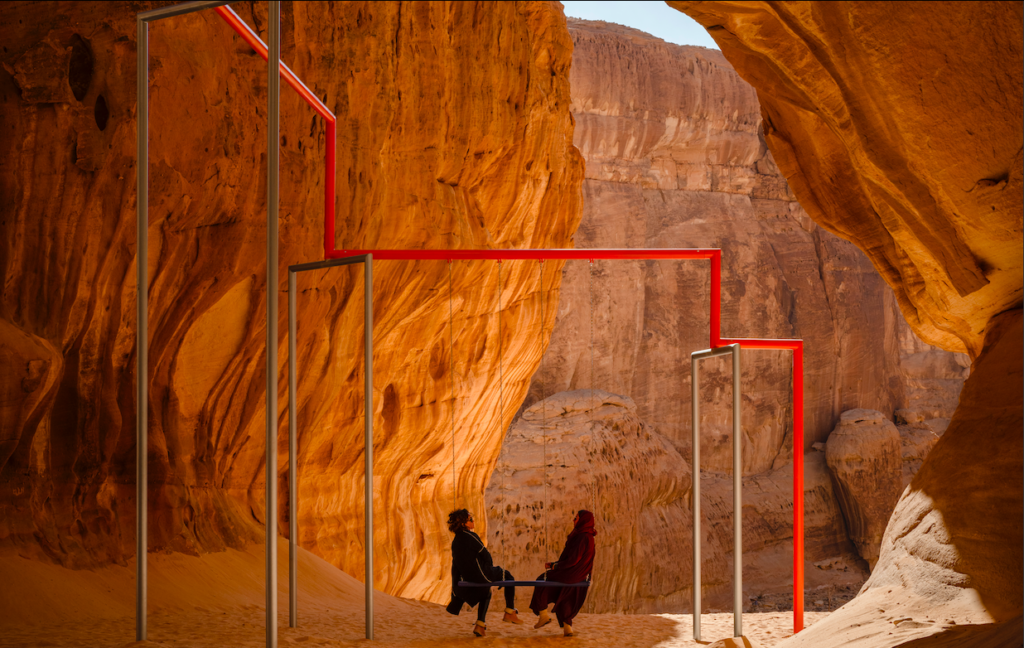
Superflex, One Two Three Swing! Installation view at Desert X AlUla, photo Lance Gerber, courtesy the artist, RCU and Desert X
There was a revolutionary spirit in the air last weekend as the inaugural edition of Desert X AlUla unveiled 14 massive structures in the mystical desert lands of Saudi Arabia. The artworks, created in accordance to the unique natural landscape of this ancient region, characterized by sand valleys, high sandstone cliffs, and enormous rocks that were reportedly once under water. Time seemed to stop momentarily in AlUla as the formidable presence of the landscape united with contemporary artworks in a most magical manner.
As human and natural creation joined in dialogue, guests moved from one artwork to the next like wide-eyed children. The interactive works offered chances to play—like jumping on Manal Al Dowayan’s trampoline’s in Now You See Me, Now You Don’t, or swinging in glee on Superflex’s One Two Three Swing!—and chances to contemplate, as in Muhannad Shono’s The Lost Path, an installation of empty oil pipes wrapped around several large crevices which led, if one followed the pipes to their origin, to a secluded space where “guests can find themselves,” the artist says.
Several works commented on AlUla’s significance as an ancient crossroads for commerce and culture. It is situated on the Incense Route, connecting Asia, Africa, and Europe for thousands of years. Saudi artist Rashed AlShashai’s A Concise Passage, a gigantic pyramid made of blue plastic crates reflects on the passage of goods from AlUla’s ancient past to its present. The pyramid, says the artist, is a universal form offering a bridge between the landscape and economic systems that affect present day national borders.
Inevitably, there were political overtones to the exhibition, on multiple levels. Before it even opened, organizers sparked a firestorm of criticism for announcing their decision to mount the show in Saudi Arabia, just a year after the murder of dissident journalist Jamal Kashoggi at the Saudi consulate in Istanbul. The Los Angeles Times art critic Christopher Knight called the show “morally corrupt” and three of its board members resigned in protest.
“Some people wouldn’t talk to me and other people were absolutely shocked that I would do it,” says Albuquerque. “When Christopher Knight wrote that article I felt very pressured and for three days I decided not to do it. I was so depressed and then I said, ‘Wait a minute, I can’t let that kind of [critique] stop me from being part of a historic moment.’”
Due to the current geopolitics and long-held stereotypes about Saudi Arabia, many artists felt immense political pressure when they decided to take part in Desert X. “A few people said ‘Are you sure you want to take this risk and be criticized?’” remembers Gisela Colon. “I said ‘Absolutely, I don’t have any fear,’ because artists need to have courage to lead the way.”
Colon’s work, The Future Is Now, a tall monolith carbon fiber projectile-shape sculpture, shoots up into the sky. It’s an object with a dual purpose, one that is primitive, recalling ancient objects, and contemporary, referencing the future. “The fact that I, as a woman originally from Puerto Rico, can put a gigantic object that has references to projectiles and bullets in the desert in Saudi Arabia is revolutionary,” she says. “They allowed me to exhibit what I wanted and there was no censorship.”
Adding another level of complexity to the show is Saudi Arabia’s history as a place that previously forbid outsiders from entry. “It is revolutionary that they [Saudi Arabia] has opened the doors and said ‘yes’ to these works,” says Albuquerque. “This is the beginning of 2020 and there is so much political pressure on this [show] and we had the guts to say ‘yes’ to this as artists. We are not going to bury are heads in the sand. We are going to hold hands, open this up, and stay together in the unknown.”
At the heart of artistic director Neville Wakefield’s mission in Desert X AlUla is cross-cultural exchange. “Site-specific artwork began nearly fifty years ago with a group of mainly white men going against the institutions of the time,” Wakefield says. “Desert X AlUla is a continuation of that legacy albeit the terms of containment are now cultural and the artists leading it much more diverse.”
The show, while co-curated by Wakefield and Saudi curators Raneem Farsi and Aya Alireza, is in a way curated by the land itself, Wakefield says. “The landscape is so rich in the broader socio-historical way,” he says. “These shows are curated by the place. Desert X signifies several firsts. Notably, it’s the first site-specific show in Saudi and the first site-specific exhibition set up as a cross-cultural dialogue.”
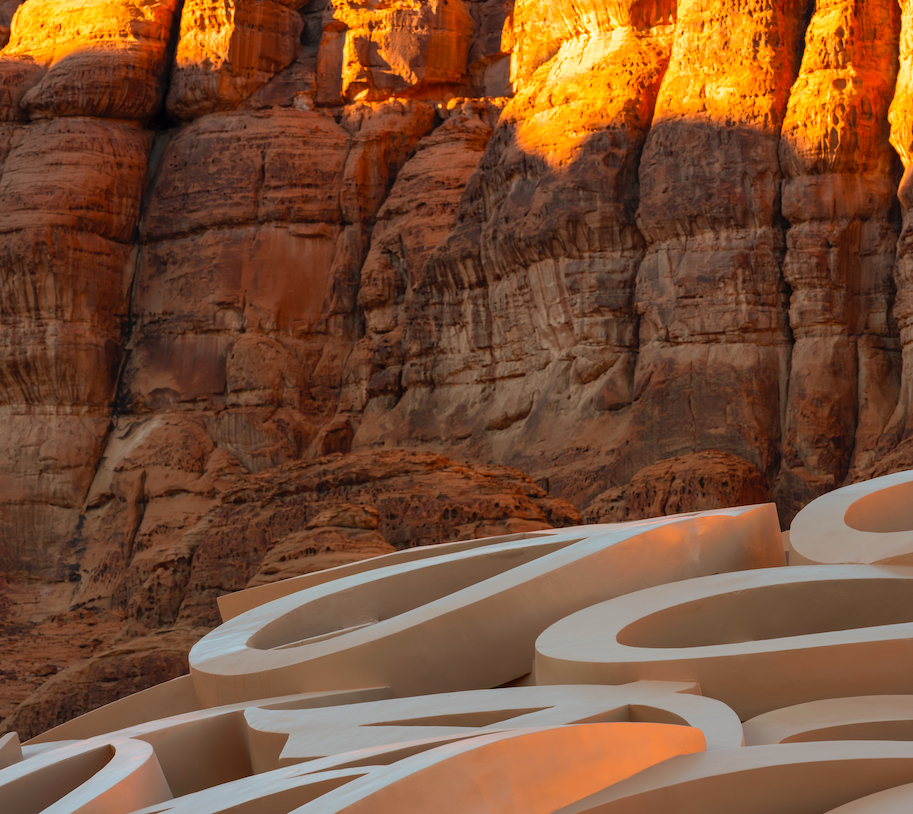
eL Seed, Mirage installation view at Desert X AlUla, photo by Lance Gerber, courtesy the artist, RCU and Desert X.
AlUla is a land that offers many stories. One is a love story dating back to the 7th century between Jameel Bin Ma’amar and Lady Buthayna from a neighboring tribe, the subject of French-Tunisian artist eL Seed’s large calligraphic sculpture, Mirage.
Buthayna’s people refuse Jameel’s marriage proposal because they feel Jameel’s verses praising their love have compromised her honor. At that time, saying that a woman loved a man was considered an act of shame in ancient Arab tribal society. Buthayna is then forced to marry another man, yet she and Jameel continue to love each other, even though their love is never consummated.
According to the story, Jameel continues to visit Buthayna in Wadi ‘I-Kura, modern-day AlUla, and complains in verse of his longing to be with her. The poetry is as much an ode to lost love as it is for the beauty of the AlUla landscape. The sand-colored calligraphic form of el Seed’s Mirage, glistens in the desert and then disappears, surrendering itself to the landscape just as Jameel surrendered himself to his ineffable love for Buthayna.
“When I arrived in AlUla, I realized it would be impossible for me to compete with the environment,” says eL Seed. “So I decided to create a work that would blend into the desert. Jameel and Butheyna were never able to be together. That’s also a mirage. Love is universal. It unites us all.”
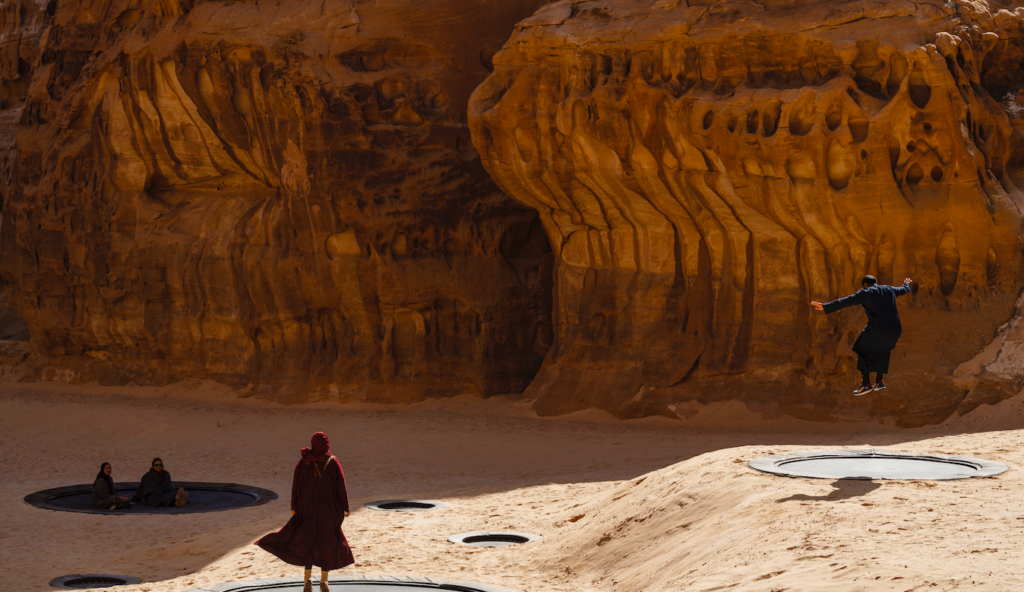
Manal AlDowayan, Now You See Me, Now You Don’t, installation view at Desert X AlUla. Photo by Lance Gerber, courtesy of the artist, RCU, and Desert X
A moment of sheer play can be had in Saudi artist Manal Al Dowayan’s Now You See Me, Now You Don’t, an installation made of several black trampolines referring to Saudi Arabia’s silent water crisis. The country has used 1,056 percent of its total renewable water sources, far exceeding the conservative global water-scarcity threshold of 20 to 40 percent. Al Dowayan refers to the crisis through the installation recalling the humble puddle through the form of the trampoline.
“We were asked to make work in a really tough environment that competed with beauty,” says Al Dowayan. “The conceptual execution of this project came through to everyone, even the local community, which was my focus. This is my country and I have immense pride and I want everybody to engage with it.”
“I was not making artwork that had to be sold,” she continues. “The artwork allowed us to address the important concern of the environment. There are no gallery or museum walls here. We were completely free to do as we wanted.”
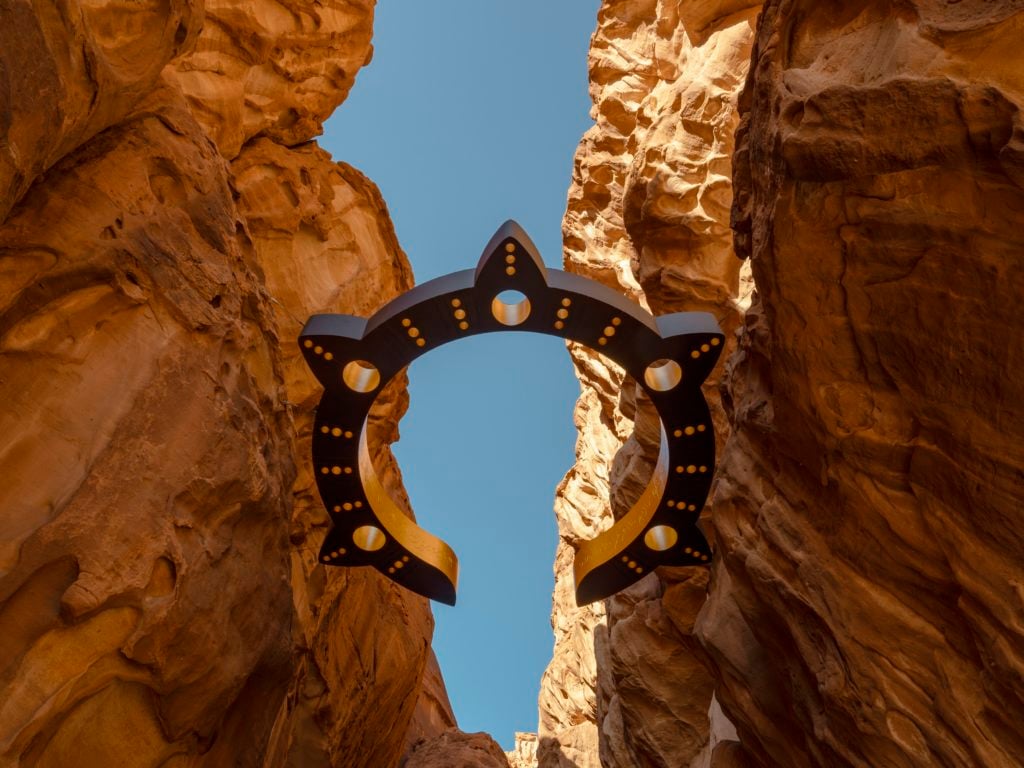
Sherin Guirguis, Kholkhal Aliaa installation view at Desert X AlUla, photo by Lance Gerber, courtesy the artist, RCU and Desert X.
Wedged high up within a rock crevice is Los Angeles-based artist Shirin Guirguis’s Kholkhal Aliaa, a Bedouin anklet given to the artist by her mother. Glistening with gold embellishment and Arabic script, the object represents cultural knowledge passed from a mother to a daughter and the idea of linking individuals across time and space. It also represents female power.
“The story of women is not often told,” says Guirguis. “I did face some backlash in the Los Angeles community but I decided to go forth because I felt it was an important initiative, specifically for a brown woman like me in an international exhibition whose work addresses the invisibility of women’s work.”
“I want to celebrate the long history of cultural work produced by women in the Middle East that has been marginalized, lost, and forgotten,” she adds. “I wanted to remind women of the impact that they have in their own community and then maybe we start seeing the Middle East in a new light and our vision of the region can evolve. You cannot have empathy for another people or culture if you don’t engage.”